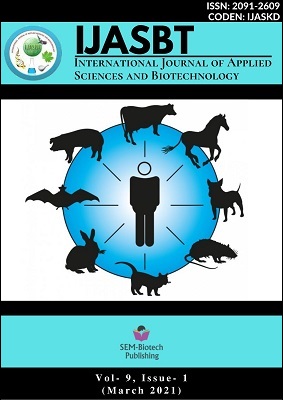Biological Property of Novel Coronavirus SARS-CoV-2 (2019-nCoV)
DOI:
https://doi.org/10.3126/ijasbt.v9i1.33333Keywords:
Coronavirus, COVID-19, HCoVs, MERS-CoV, SARS-CoV-2Abstract
Novel coronavirus (2019-nCoV) is a positive-sense RNA virus that possesses four genes that encode the spike (S), membrane (M), nucleocapsid (N), and envelope (E) proteins. The virus was originated in seafood market selling live animals and responsible for coronavirus disease 2019 (COVID-19). The initial case was traced to the city of Wuhan in the province of Hubei, China, reported as an emerging respiratory virus, the outbreak was reported to WHO on December 31, 2019, and soon after identified the causative pathogen as a beta coronavirus named as severe acute respiratory syndrome coronavirus 2 (SARS-CoV-2); Furthermore, It is a highly contagious virus that spreads swiftly outside of China in March and the World Health Organization had to declare COVID-19 pandemic on March 11, 2020, and as of August 15, 2020, more than 21 million confirmed cases have been reported, with > 755 786 deaths worldwide. This day’s novel coronavirus-2019 is the most infectious virus with high infectivity and low mortality rate where a high mortality rate was observed among people above the age of sixteen (60) years and with the pre-existing health condition. To date, there is no clinically approved antiviral drug or vaccine available to be used against COVID-19. However, Preventive measures such as masks, hand hygiene practices, avoidance of public contact, case detection, contact tracing, and quarantines have been discussed as ways to reduce transmission. Therefore, the purpose of this review is to summarize the basic biological properties of novel coronavirus 2019.
Int. J. Appl. Sci. Biotechnol. Vol 9(1): 16-22




